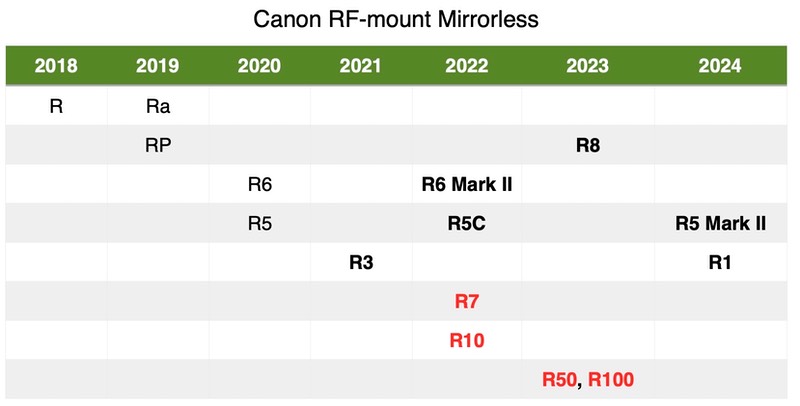
Bold equals current camera, Black is full frame, Red is APS-C frame
The EOS RF mount was designed for full frame cameras, of which we have six current models right now (one is a cinema version of an earlier camera). In 2022, Canon expanded that to include crop-sensor cameras, of which we now have four. To some degree, Canon is mimicking their DSLR lineup with most of these cameras: the R8 is basically equivalent to the 6D Mark II DSLR, the R5 Mark II is an updated variation of the 5D Mark IV DSLR, while the R7 is basically a 90D DSLR replacement.
The R8 is the low-end full frame model; it appeals mostly to budget-conscious consumers, not pros and high-end enthusiasts. The R1, R3, and R5 Mark II appeal to different needs of those pros and high-end enthusiasts. The R6 Mark II is the "goldilocks" camera in between.
RF-S refers to crop sensor (APS-C) cameras, for which we have a full line now. From bottom to top: R100, R50, R10, R7.
Here's my advice with cameras here in 2024:
- On a strict budget: buy the R8 for full frame, the R10 for APS-C. Both are really competent cameras for their price.
- Looking for overall excellence: In full frame buy the R6 Mark II if you don't have a need for lots of pixels or 8K, the R5 Mark II otherwise. In APS-C the best camera is clearly the R7.
- Need fast focus and frame rates: buy the R1 or R3 if you can, but the R7 isn't a bad lower price option if you can tolerate a crop sensor.
The RF cameras can use EF and EF-S DSLR lenses via an adapter. Canon actually makes three EF-to-RF adapters: a basic one, one that adds an additional control ring to the lens, and one that allows drop in filters within the adapter. All three adapters work quite well with virtually every EF lens Canon has made, and with most third party EF lenses, too. Note that the R8, R50, and R100 do not have sensor-based stabilization, so you'd prefer adapting EF lenses with IS over ones without IS.
Speaking of lenses, the RF native lenses are still a work in progress at the moment, and many of the available lenses are either L lenses (high-end), or aperture compromised less expensive ones. Most full frame buyers with quality in mind are likely going to get the 24-105mm f/4 L IS, or perhaps the 24-70mm f/2.8 L IS for the primary mid-range.
All the f/2.8 zooms are all very good, as are the 50mm and 85mm f/1.2 primes. The 100-500mm f/4-7.1L is a really good telephoto option. I'd suggest R5/R6 users start with the 24-105mm f/4L and supplement with the lenses just mentioned. The 24-100mm f/4 and 100-500mm f/4-7.1L make for a really strong 24-500mm starting kit for full frame.
Buyers of the crop sensor R7, R10, R50, and R100 are currently still somewhat starved for lenses, as there are only three RF-S lenses so far. The 18-150mm f/3.5-6.3 IS is a decent lens, but we really need more and better choices than Canon has provided so far.
One thing to be aware of is that Canon M and Canon RF mounts aren't compatible in any way. If you're thinking about using an M camera and an RF camera from Canon, you're going to either need two lens sets (M and RF) or dip heavily in the DSLR EF lenses via mount adapters.
